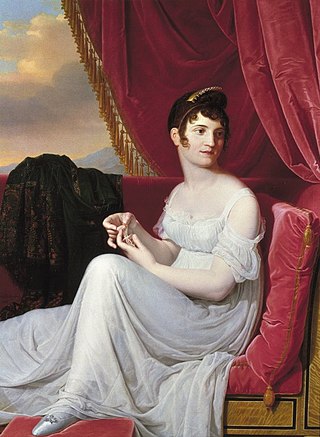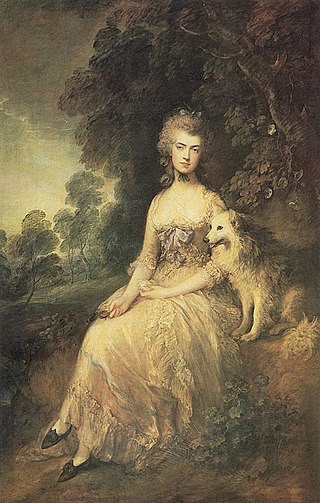
Edward Hyde, 3rd Earl of Clarendon, styled Viscount Cornbury between 1674 and 1709, was an English aristocrat and politician. Better known by his noble title Lord Cornbury, he was propelled into the forefront of English politics when he and part of his army defected from the Catholic King James II to support the newly arrived Protestant contender, William III of Orange. These actions were part of the beginning of the Glorious Revolution of 1688. Cornbury's choice to support his cousin Anne instead of William after the rebellion cost him his military commission. However, Cornbury's support of King William's reign eventually earned him the governorship of the provinces of New York and New Jersey; he served between 1701 and 1708.

Me and My Girl is a musical with music by Noel Gay and its original book and lyrics by Douglas Furber and L. Arthur Rose. The story, set in the late 1930s, tells of an unapologetically unrefined Cockney gentleman named Bill Snibson, who learns that he is the 14th heir to the Earl of Hareford. The action is set in Hampshire, and in Mayfair and Lambeth in London.

Thérésa Cabarrus, Madame Tallien was a Spanish-born French noblewoman and socialite who became Princess of Chimay during her lifetime.

Picpus Cemetery is the largest private cemetery in Paris, France, located in the 12th arrondissement. It was created from land seized from the convent of the Chanoinesses de St-Augustin, during the French Revolution. Just minutes away from where the guillotine was set up, it contains 1,306 victims executed between 14 June and 27 July 1794, during the height and last phase of the Reign of Terror.

Francis Loftus Sullivan was an English film and stage actor.

Don't Lose Your Head is a 1967 British swashbuckling comedy film, the 13th in the series of 31 Carry On films (1958–1992). It features regular team members Sid James, Kenneth Williams, Jim Dale, Charles Hawtrey, and Joan Sims. Set in France and England in 1789 during the French Revolution, it is a parody of Baroness Orczy's The Scarlet Pimpernel.
Anything for a Quiet Life is a Jacobean stage play, a city comedy written by Thomas Middleton and John Webster. Topical allusions suggest the play was written most likely in 1621.

La Révolution française is a two-part 1989 historical drama co-produced by France, Germany, Italy and Canada for the 200th anniversary of the French Revolution. The full film runs at 360 minutes, but the edited-for-television version is slightly longer. It purports to tell a faithful and neutral story of the Revolution, from the calling of the Estates-General to the death of Maximilien de Robespierre. The film had a large budget and boasted an international cast. It was shot in French, German and English.

The Scarlet Pimpernel is a 1934 British adventure film directed by Harold Young and starring Leslie Howard, Merle Oberon, and Raymond Massey. Based on the 1905 play by Baroness Orczy and Montagu Barstow and the classic 1905 adventure novel by Orczy, the film is about an eighteenth-century English aristocrat (Howard) who leads a double life, passing himself off as an effete aristocrat while engaged in a secret effort to rescue French nobles from Robespierre's Reign of Terror. The film was produced by Alexander Korda. Howard's portrayal of the title character is often considered the definitive portrayal of the role. In 1941, he played a similar role in "'Pimpernel' Smith" but this time set in pre-WWII Germany.

Lady Oscar is a 1979 English-language romantic period drama film, based on the manga The Rose of Versailles by Riyoko Ikeda. The film was written and directed by Jacques Demy, with music composed by his regular collaborator Michel Legrand. The Japanese-French co-production was produced by Mataichiro Yamamoto for Kitty Films, Nippon TV, Toho, and Ciné Tamaris, and was filmed on location in France.

Edward Charles Baring, 1st Baron Revelstoke, was a British banker.

The Scarlet Pimpernel is a 1982 British romantic adventure television film set during the French Revolution. It is based on the novels The Scarlet Pimpernel (1905) and Eldorado (1913) by Baroness Emmuska Orczy, and stars Anthony Andrews as Sir Percy Blakeney/the Scarlet Pimpernel, the protagonist, Jane Seymour as Marguerite St. Just, the love interest, and Ian McKellen as Chauvelin, the antagonist.
William Conyers, 1st Baron Conyers, also known as William Conyers of Hornby, was an English baron and aristocrat.
Her Last Affaire is a 1935 British drama film directed by Michael Powell and starring Hugh Williams, Viola Keats, Cecil Parker and Googie Withers. The wife of a politician is found dead at a country inn. It was based on the play S.O.S. by Walter Ellis.

The Return of the Scarlet Pimpernel is a 1937 British film directed by Hanns Schwarz and starring Barry K. Barnes, Sophie Stewart, Margaretta Scott and James Mason. It is a sequel to the 1934 film The Scarlet Pimpernel based on the stories by Baroness Emmuska Orczy.

Webster Booth was an English tenor, best remembered as the duettist partner of Anne Ziegler. He was also one of the finest tenors of his generation and was a distinguished oratorio soloist.

Anne Ziegler was an English singer, known for her light operatic duets with her husband Webster Booth. The pair were known as the "Sweethearts in Song" and were among the most famous and popular British musical acts of the 1940s.

Kate Plus Ten is a 1938 British thriller film directed by Reginald Denham and starring Jack Hulbert, Genevieve Tobin and Noel Madison. It was adapted from the Edgar Wallace novel Kate Plus Ten. It was also released as Queen of Crime.
The Elusive Pimpernel is a 1919 British silent adventure film directed by Maurice Elvey and starring Cecil Humphreys, Marie Blanche and Norman Page. It was based on the 1908 novel The Elusive Pimpernel by Baroness Orczy.

The Natural Daughter with Portraits of the Leadenhead Family is a novel by the English poet, dramatist and novelist Mary Robinson, published in 1799 by T. N. Longman and O. Rees in Paternoster Row in London. The novel was originally published as two volumes; a thousand copies were printed for the first edition of the novel. All the copies sold out quickly, leading to the book's second publication in the same year. This romantic prose narrative is often thought to be Robinson's commentary on the French Revolution and the ideals of the English woman, due to the various characters influenced by France and the members of the revolution who appear in the novel.
















